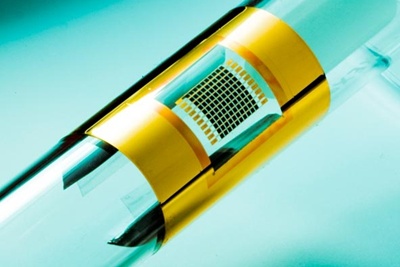Semprius CPV module factory ready to roll 18 Sep 2012 Site in Henderson,North Carolina,will reach production run-rate of 6 MW by the middle of next year.

Micro-transfer printing
Semprius,the developer of high-efficiency concentrated photovoltaics(CPV)modules based on extremely small solar cells -even for CPV-will open its new Henderson,North Carolina,manufacturing site next week.
The facility,currently employing 50 people,is being set up with an initial production run-rate of 6MW.It will make modules using Semprius' proprietary micro-transferring process-a technology previously shown to deliver record-breaking module conversion efficiencies of nearly 34%.
On September 26,Semprius'CEO Joe Carr will officially open the Henderson site alongside the North Carolina governor Bev Perdue and local Democrat representative James Crawford.
"It's a major milestone for Semprius,and we're very proud of our team and our public and private partners that have helped us bring it in on time and on budget,"said Carr in a company statement."With production ramped up,we will be able to effectively service our customers,including companies like Siemens and Pratt&Whitney Rocketdyne."
Siemens is also an investor in Semprius,via its venture capital wing.The engineering giant bought a 16%stake in the start-up,originally a spin-out from the University of Illinois,last June,while Carr used to head up the German engineering giant's Osram Opto Semiconductors subsidiary.
30 MW capacity within easy reach
Carr told optics.org that the company had project work under way that could exceed the initial 6 MW nameplate capacity,but added that the plant could be"de-bottlenecked"to reach a 30 MW capacity with only a very modest increase in equipment.The company plans to hire more than 250 people if its expansion goes according to plan.
The CEO added that most of the current customer demand was utility-driven,and emanating from outside the US market.
That contrasts with the mixed fortunes of Amonix,the Californian company that has dominated the early commercial phase of the emerging CPV sector.It recently completed a 30 MW installation in Colorado that represents the largest operational CPV facility yet to be built,but has also been forced to shut its manufacturing site in Nevada after demand failed to meet prior expectations.
The major difference between that facility and Semprius' is that the Amonix's had a much larger capacity,of approximately 100 MW.Amonix's"megamodule"CPV systems are also much larger.
There was more bad news for the CPV sector as recently as last week,with the sudden demise of California-based GreenVolts after its key investor ABB apparently decided to pull the plug on the venture in the face of cut-throat competition from crystalline silicon PV modules.
Cost and reliability
Commenting on the current market environment surrounding CPV,Carr said:"The issue boils down to cost and reliability.To compete with the declining pricing of silicon and thin-film,one must have a system in which every material choice and every design parameter is cost-optimized while achieving 25 years life expectancy"
"With literally hundreds of design analyses,we have left nothing to chance,"the CEO added."We don't believe a"Fresnel[lens]on a box"can get to this level of optimization."
While GreenVolts was backed by ABB,Semprius has received investment from ARCH Venture Partners,Illinois Ventures,Intersouth Partners,the CIA's investment wing In-Q-Tel and Morgan Creek Capital Management,as well as Siemens.
Together,they have invested some$40 million in the start-up over the past 15 months,while Semprius has also received state and county incentives worth another$8 million.
Like many of the PV players in the US,the company's proprietary technology was developed in collaboration with the National Renewable Energy Laboratory(NREL).While all CPV is based on the principle of focusing sunlight onto small but highly efficient multi-junction cells,Semprius takes that a step further by using even smaller cells just the size of a pencil point.
Under clear skies,the resulting modules offer twice the efficiency of conventional silicon PV modules,though like all CPV technologies they are more expensive and must track the sun closely.The key question-as with any company targeting the CPV space-is how much the technology costs,and whether the market will be prepared to adopt it at a time when the price of those conventional modules continues to slide.





